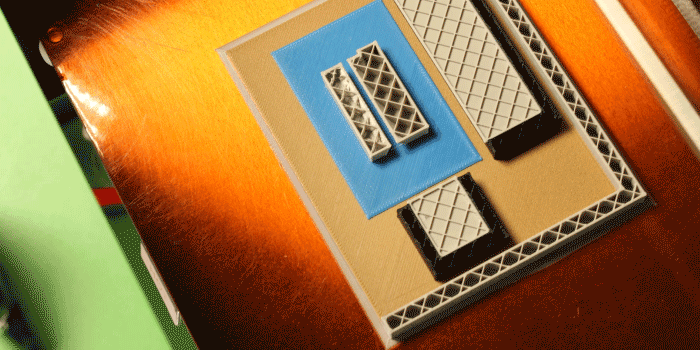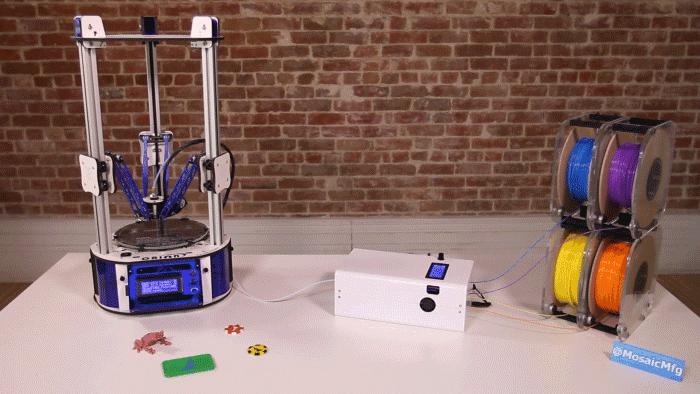Mosaic Manufacturing Launches The Palette — Turn Any 3D Printer into a Multi-Color, Multi-Material Machine
 For many of us who own a 3D printer, the monotone objects which we fabricate on a daily basis may begin to appear a bit boring. Every day, new machines enter the market, many equipped with two, three, or even four extruders, enabling users to print objects in multiple colors. Where does this leave those of us who recently purchased a single extrusion 3D printer? Well, sometimes a bit jealous.
For many of us who own a 3D printer, the monotone objects which we fabricate on a daily basis may begin to appear a bit boring. Every day, new machines enter the market, many equipped with two, three, or even four extruders, enabling users to print objects in multiple colors. Where does this leave those of us who recently purchased a single extrusion 3D printer? Well, sometimes a bit jealous.
Back in November of last year, we reported that Ontario, Canada-based company, Mosaic Manufacturing had created a device which allowed virtually any 3D printer to become a multi-color, multi-material printer. The system basically functioned to combine two filaments prior to the material ever being fed into the printer itself.
Today Mosaic Manufacturing has taken this concept a step further, launching a Kickstarter campaign for a product they call The Palette. The Palette functions in a similar way to the prototype machine we saw last November, but is sleeker and able to handle up to four separate filament strands at once.
“The promise of 3D printing as a communications tool has not been fully realized because of the single colour limitation placed on 3D printers today. The Palette brings new capabilities to a wide range of people who already own 3D printers,” said Chris Labelle, Co-founder and COO of Mosaic Manufacturing. “For us, Kickstarter is a great way to connect with a wide variety of people who use 3D printing technologies. Over the next 30 days, our backers will have an opportunity to play a key role in bringing The Palette to life..”
The Palette is an intermediary between the computer and virtually any FFF/FDM desktop 3D printer, whether Cartesian or Delta-Style. Up to four strands of filament, with varying colors as well  as properties (ie. conductive, magnetic, color-changing, etc) are manually fed into The Palette. When the .gcode warrants a color or property change, The Palette will cut the current strand of filament and fuse it with the new one. A scroll wheel between The Palette and the printer will constantly monitor the filament being used and report back to The Palette which knows exactly when to cut and fuse the next filament for the project.
as properties (ie. conductive, magnetic, color-changing, etc) are manually fed into The Palette. When the .gcode warrants a color or property change, The Palette will cut the current strand of filament and fuse it with the new one. A scroll wheel between The Palette and the printer will constantly monitor the filament being used and report back to The Palette which knows exactly when to cut and fuse the next filament for the project.
Unlike 3D printers which come equipped with multiple extruders, those using The Palette do not have to sacrifice their build volume for multiple materials. Additionally, those using this new device will find that there is no dripping or smearing from the paused extruders, which one would typically experience while using a printer with multiple extruders.
As for the software, which Mosaic Manufacturing has decided to make open source, it’s rather simple. First a user saves their 3D model as multiple .STL files using the same modeling and slicing programs that they are used to. Then the software will piece together and slice the .STL files before analyzing the .gcode or .x3g slicer output. Once complete, the software will produce a modified .gcode or .x3g file that can be sent to the printer, and a .SEEM file is sent to The Palette via a provided SD card. The print is then ready to begin.
The team behind Mosaic Manufacturing has been working on this device for over a year now, and they are ready to begin taking pre-orders via Kickstarter. The campaign, which launched earlier today, seeking $61,414, has already brought in over $56,000, with more than a month remaining. Mosaic Manufacturing is offering The Palette in various packages and at various prices dependent  on how quickly they are pre-ordered. While the first 20 backers were able to pre-order the device for just $599 and the next 20 for $749, these rewards quickly sold out. Currently backers are able to pre-order The Palette starting at $849. If all goes as planned, the very first units will begin shipping to Early Bird backers in December of this year, and full-scale production will commence around January of 2016.
on how quickly they are pre-ordered. While the first 20 backers were able to pre-order the device for just $599 and the next 20 for $749, these rewards quickly sold out. Currently backers are able to pre-order The Palette starting at $849. If all goes as planned, the very first units will begin shipping to Early Bird backers in December of this year, and full-scale production will commence around January of 2016.
Certainly this device is something rather unique to the market. The ability to mix filaments with various property could have a tremendous impact on those looking to print objects with electrical traces within, as well as small and medium sized businesses which require multi-color fabrication.
Let us know if you have pre-ordered Mosaic Manufacturing’s latest device. Discuss in The Palette forum thread on 3DPB.com Check out the Video explaining the process below:
Subscribe to Our Email Newsletter
Stay up-to-date on all the latest news from the 3D printing industry and receive information and offers from third party vendors.
You May Also Like
Why Corrosive Resistant Materials Are Important to the Success of 3D Printing Across Industries
The adoption of additive manufacturing (AM) is accelerating across many major industries. As this technological shift unfolds, the importance of corrosion resistance has emerged as a challenge for 3D printing...
America Makes Announces IMPACT 2.0: $6.6M in New 3D Printing Funding
America Makes, the Manufacturing Innovation Institute (MII) based in Youngstown, Ohio, has announced IMPACT (Improvement in Manufacturing Productivity via Additive Capabilities and Techno-Economic Analysis) 2.0, a project call which will...
3D Printing Webinar and Event Roundup: April 14, 2024
We’re starting off the week’s 3D printing webinars and events at ASTM AMCOE’s 11th Snapshot Workshop and MACH Exhibition. Stratasys continues its advanced training courses, SME is holding a virtual...
AMUK Welcomes Airframe Designs as British 3D Printing Industry Grows
While the UK is not the hub for 3D printer and materials manufacturers as other nations, the country continues to excel at the research, development, and application of additive manufacturing...

































